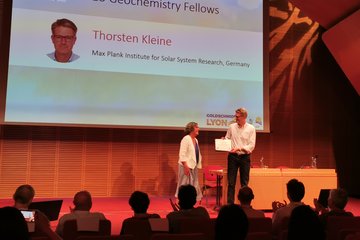Alle Typen
61.
Zeitschriftenartikel
From solar to stellar brightness variations: The effect of metallicity. Astronomy and Astrophysics 619, A146 (2018)
62.
Zeitschriftenartikel
The PMIP4 contribution to CMIP6 – Part 3: The last millennium, scientific objective, and experimental design for the PMIP4 past1000 simulations. Geoscientific Model Development 10, S. 4005 - 4033 (2017)
63.
Zeitschriftenartikel
The nature of solar brightness variations. Nature astronomy 1, S. 612 - 616 (2017)
64.
Zeitschriftenartikel
NESSY: NLTE spectral synthesis code for solar and stellar atmospheres. Astronomy and Astrophysics 603, A27 (2017)
65.
Zeitschriftenartikel
Solar disc radius determined from observations made during eclipses with bolometric and photometric instruments on board the PICARD satellite. Astronomy and Astrophysics 603, A28 (2017)
66.
Zeitschriftenartikel
Solar irradiance observations with PREMOS filter radiometers on the PICARD mission: In-flight performance and data release. Astronomy and Astrophysics 588, A126 (2016)
67.
Zeitschriftenartikel
Are solar brightness variations faculae- or spot-dominated? Astronomy and Astrophysics 589, A46 (2016)
68.
Zeitschriftenartikel
Evaluation of simulated photolysis rates and their response to solar irradiance variability. Journal Geophysical Research 121 (10), S. 6066 - 6084 (2016)
69.
Zeitschriftenartikel
The role of the Fraunhofer lines in solar brightness variability. Astronomy and Astrophysics 581, A116 (2015)
70.
Zeitschriftenartikel
The Infrared Solar Spectrum Measured by the SOLSPEC Spectrometer Onboard the International Space Station. Solar Physics 290, S. 1581 - 1600 (2015)
71.
Buchkapitel
The Sun's Atmosphere. In: The Sun as a Guide to Stellar Physics, S. 59 - 85 (Hg. Engvold, O.; Vial, .-C.; Skumanich, A.). Elsevier, Amsterdam (2019)
72.
Konferenzbeitrag
FM9 - Solar Irradiance: Physics-Based Advances. In: Proceedings of the International Astronomical Union, Bd. 14, S. 331 - 332. (2020)
73.
Konferenzbeitrag
Spectral solar variations during the eclipse of March 20th, 2015 at two European sites. In: AIP Conference Proceedings, Bd. 1810, 080008. American Institute of Physics (2017)
74.
Konferenzbeitrag
Modelling solar and stellar brightness variabilities. In: Coimbra Solar Physics Meeting: Ground-based Solar Observations in the Space Instrumentation Era, Bd. 504, S. 273 - 286. (2016)
75.
Vortrag
Solar brightness variations as they would be observed by the Kepler telescope. Observing the Sun as a star: Would we find the solar system if we saw it?, Göttingen, Germany (2018)
76.
Vortrag
Solar brightness variations as observed by the Kepler telescope. XXXth General Assembly of the International Astronomical Union, Vienna, Austria (2018)
77.
Vortrag
The solar irradiance: observations and modelling. European Geosciences Union General Assembly, Vienna, Austria (2015)
78.
Vortrag
Solar brightness variability in the stellar context. Second SOLARNET Meeting on "Solar and stellar magnetic activity, Palermo, Italy (2015)
79.
Vortrag
Brightness variations of the Sun and Sun-like stars. Solar-Stellar Connection Workshop, Sandbjerg, Denmark (2015)
80.
Vortrag
Modelling stellar brightness variations. Stellar and Planetary dynamos, Göttingen, Germany (2015)











